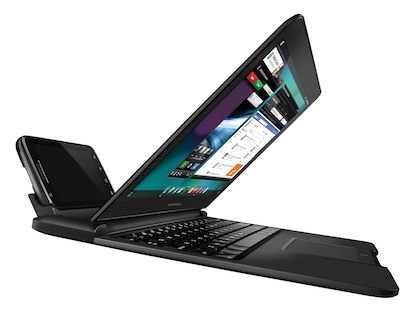
By itself, the Motorola Atrix was but one of the dozen or so large-screened Android smartphones that invaded CES 2011, but what really set it apart was its lapdock accessory. This clamshell combination of a full-sized keyboard, screen and battery allow the Atrix to function more like a Linux smartbook.
Extending the processing and connectivity of a smartphone to notebook proportions is, of course, not a new idea. The pre-Elevation Palm sort of tried it with the Foleo, which was a mostly independent device and in some ways a closer ancestor to the BlackBerry Playbook. Celio implemented it with the Redfly, although that product was tied to the unpopular Windows Mobile OS and later BlackBerry, where it was poorly integrated. Rather than a dock, both solutions were able to use bandwidth-constrained Bluetooth to pair the input and output enhancement to the phone. In the case of the Redfly, a cable could also be used.
The Atrix 4G lapdock solution seems like it will work better than those approaches, but in the excitement over a smartphone that can apparently transform into a laptop, I think we’ve been too quick to overlook the lapdock’s strange design, in which the Atrix is docked behind the screen. This allows for easy connection and disconnection of the smartphone, but it doesn’t allow for use of both screens simultaneously. More importantly, it doesn’t allow you to easily transport the docked Atrix within the lapdock. I’d be surprised if a competitor taking a crack at this didn’t make it so that the phone is inserted securely inside the clamshell, allowing for sufficient ventilation, of course.
This post syndicated from Ross Robin’s Out of the Box. Ross is executive director of industry analysis for consumer technology at market research and analysis firm The NPD Group, a columnist for abcnews.com, and senior columnist for Engadget.
This contraption left me saying all kinds of wtf? So every app will have to be stretched to display fully on the larger screen, basically killing fidelity. The web browser in the dock itself isn’t even an app from the phone? I guess the scaled browser on the phone looked like crap so they had to replace it with firefox??
Don’t get me started on the TV dock. Zero usability in that design. Just try entering a URL on your phone while its in the freaking dock tethered to your TV 10 feet away. And oh yeah, did you notice all the wires connecting the dock to the TV? If that is mobility then I want no part of it.
How about a dock that lets you hold the phone and utilize its input methods via Wifi direct or something.
Like the concept, but terrible implementation.
Your wrong about not being able to use both screens whens its docked. The phone shows up on the mini laptop screen as well. So you can work with the phone interface and the firefox interface at the same time. You can do some things from the phone in full screen.
I believe Ross is referring to the fact that the phone’s screen goes dark as soon as you pop it into the dock. Yes you can access it as a virtual device in a window, but a true second screen (for widgets!) could have been useful.
I think Nilay from the Engadget Showcast came up with the correct integration mode:
The phone slides in the front and becomes the touchpad.
The thickness of the front is compromised a bit, but now you save on the COGs of a good mutli-touch trackpad.
The first thing that came to my mind looking at the picture is a disaster waiting to happen when you try to use this “computer” on an airplane and the person in front of you decides to quickly put his seat back. It looks like the phone would snap right off.
Another stupid idea. It sounds like the two versions aren’t even particularly integrated. The PC just runs a Linux OS it boots off the phone. Big freaking deal.
Last year it was that stupid Lenovo hybrid that ran Linux as a Tablet, then booted to Windows when you docked it with the keyboard? All the press drooled over it. Why I have no idea. That was a stupid idea too.
Seems like there are various reasonable approaches here. First just connect with the phone via tethering or Wifi. What’s the point of the physical connection again?
Second, EITHER have the hybrid laptop share all the data with the phone (contacts, calendar etc) but present a BETTER/HIGHER RES UI, OR just make it a Windows PC.
This is stupid. I’d bet it won’t ship. If it does it’ll be a failure.